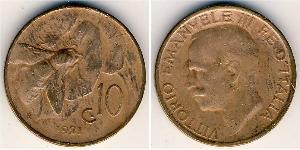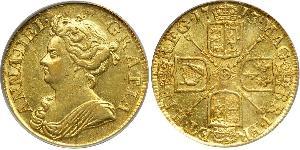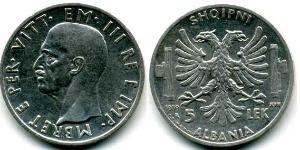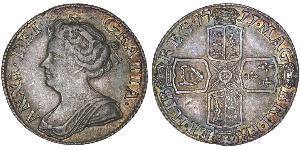[ 0827] Hadrian - Roman Emperor: 117-138 A.D. - Silver Tridrachm 25mm (10.12 grams) of Aigeai, Cilicia. Dated Caesarean Era 164 = 117/118 AD. Reference: Prieur 716; SNGLev 1713; SNGFr 2328 Obverse: AYTOKP KAIC TPAIANOC AΔPIANOC CЄB, laureate bust right, slight drapery on left shoulder. Reverse: AIΓЄAIΩN ЄTOYC ΔΞP, Amaltheia standing facing, head right, holding cornucopiae & infant Zeus, who crowns her; at feet, goat kneeling right, head left. In Greek mythology, Amalthea or Amaltheia (Greek: Ἀμάλθεια) is the most often mentioned among foster-mothers of Zeus. Her name in Greek ("tender goddess") is clearly an epithet, signifying the presence of an earlier nurturing goddess,[1] whom the Hellenes, whose myths we know, knew to be located in Crete, where Minoans may have called her a version of "Dikte".[2] Amalthea is sometimes represented as the goat who suckled the infant-god in a cave in Cretan Mount Aigaion ("Goat Mountain"),[3] sometimes as a goat-tending nymph[4] of uncertain parentage (the daughter of Oceanus, Haemonius, Olenos,[5] or - according to Lactantius — Melisseus[6]), who brought him up on the milk of her goat.[7] Having multiple and uncertain mythological parents, indicates wide worship of a deity in many cultures having varying local traditions. Amalthea becomes blurred with Adamanthea at times.In the tradition represented by Hesiod's Theogony, Cronus swallowed all of his children immediately after birth. The mother goddess Rhea, Zeus' mother, deceived her brother consort Cronus by giving him a stone wrapped to look like a baby instead of Zeus. Since she instead gave the infant Zeus to Adamanthea to nurse in a cave on a mountain in Crete, it is clear that Adamanthea is a doublet of Amalthea. In many literary references, the Greek tradition relates that in order that Cronus should not hear the wailing of the infant, Amalthea gathered about the cave the Kuretes or the Korybantes to dance, shout, and clash their spears against their shields.[8] Provided with certificate of authenticity. CERTIFIED AUTHENTIC by Sergey Nechayev, PhD - Numismatic Expert Publius Aelius Hadrianus (as emperor Imperator Caesar Divi Traiani filius Traianus Hadrianus Augustus, and Divus Hadrianus after his apotheosis, known as Hadrian in English; 24 January 76 – 10 July 138) was emperor of Rome from AD 117 to 138, as well as a Stoic and Epicurean philosopher. A member of the gens Aelia, Hadrian was the third of the so-called Five Good Emperors. Hadrian was born Publius Aelius Hadrianus in Italica or, less probably, in Rome, from a well-established family which had originated in Picenum in Italy and had subsequently settled in Italica, Hispania Baetica (the republican Hispania Ulterior), near the present day location of Seville, Spain. His predecessor Trajan was a maternal cousin of Hadrian's father. Trajan never officially designated a successor, but, according to his wife, Pompeia Plotina, Trajan named Hadrian emperor immediately before his death. Trajan's wife was well-disposed toward Hadrian: Hadrian may well have owed his succession to her. Hadrian's presumed indebtedness to Plotina was widely regarded as the reason for Hadrian's succession. However, there is evidence that he accomplished his succession on his own governing and leadership merits while Trajan was still alive. For example, between the years AD 100–108 Trajan gave several public examples of his personal favour towards Hadrian, such as betrothing him to his grandniece, Vibia Sabina, designating him quaestor Imperatoris, comes Augusti, giving him Nerva's diamond "as hope of succession", proposing him for consul suffectus, and other gifts and distinctions. The young Hadrian was Trajan's only direct male family/marriage/bloodline. The support of Plotina and of L. Licinius Sura (died in AD 108) were nonetheless extremely important for Hadrian, already in this early epoch. Payment & Shipping: Will accept payments ...
type to read more

|
Posted by:
anonymous 2015-08-19 |
Similar Coin Groups
2025-05-24
- Historical Coin Prices
2025-05-24
- Historical Coin Prices
You may be interested in ...





















